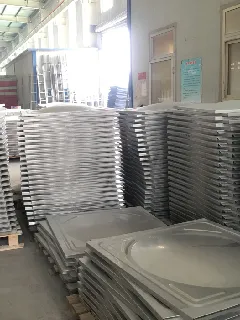loading...
- No. 9, Xingyuan South Street, Dongwaihuan Road, Zaoqiang County, Hengshui, Hebei, China
- admin@zjcomposites.com
- +86 15097380338
- Welcome to visit our website!
fiber reinforced polymer bars
Fiber Reinforced Polymer Bars Revolutionizing Construction and Engineering
In the modern age, construction and engineering sectors continuously seek innovative materials to enhance the durability, sustainability, and efficiency of structures. Among these advanced materials, Fiber Reinforced Polymer (FRP) bars have emerged as game-changers, particularly in reinforcing concrete structures. This article aims to explore the properties, applications, advantages, and challenges associated with FRP bars, highlighting their role in transforming traditional construction practices.
What Are Fiber Reinforced Polymer Bars?
Fiber Reinforced Polymer bars are composite materials consisting of a polymer matrix reinforced with fibers. These fibers are typically made from materials such as glass, carbon, or aramid, which provide the bars with enhanced mechanical properties. The polymer matrix can be a variety of materials, including epoxy, vinylester, or polyester, depending on the desired characteristics for specific applications.
FRP bars are lightweight yet strong, making them an attractive alternative to traditional steel reinforcement. Their development was prompted by the need to address limitations associated with conventional materials, particularly corrosion susceptibility and heavy weight.
Properties of FRP Bars
One of the most compelling features of FRP bars is their excellent corrosion resistance. Unlike steel, which can degrade in the presence of moisture and various chemicals, FRP bars maintain their integrity even in harsh environments, such as marine applications or chemical processing facilities. This property significantly extends the lifespan of structures, reducing maintenance costs and enhancing overall safety.
Additionally, FRP bars exhibit a high strength-to-weight ratio. Their lightweight nature facilitates easier handling and installation, reducing labor costs and time on construction sites. Furthermore, the non-magnetic nature of FRP materials makes them ideal for use in a variety of specialized applications, such as MRI facilities and other environments where electromagnetic interference must be minimized.
Applications of FRP Bars
FRP bars have found applications across a diverse array of fields. In civil engineering, they are primarily used for reinforcing concrete structures, particularly in bridges, tunnels, and parking garages. The corrosion resistance of FRP makes it particularly suitable for structures exposed to deicing salts and seawater.
Moreover, FRP bars are increasingly utilized in the construction of retrofitting existing structures. By strengthening aging infrastructure, engineers can enhance safety and extend the service life of older buildings, ensuring they can withstand modern demands.
fiber reinforced polymer bars

In addition to civil engineering, FRP bars have applications in sectors such as aerospace and automotive, where weight reduction is critical for improving fuel efficiency and performance. Their versatility makes FRP bars a valuable asset in many industries that prioritize weight and durability.
Advantages of Using FRP Bars
The advantages of utilizing FRP bars are manifold. Firstly, their resistance to corrosion leads to longer-lasting structures and reduced maintenance needs. As a result, long-term costs associated with repair and replacement of materials diminish significantly.
Secondly, the lightweight nature of FRP bars aids in faster construction and simpler handling. This efficiency not only accelerates project timelines but also lowers labor-related costs, allowing projects to stay on budget and deliver results sooner.
Lastly, FRP bars offer design flexibility. Engineers can innovate designs that leverage the unique mechanical properties of FRP materials, enabling the construction of structures that meet specific performance criteria, which might be difficult to achieve using traditional materials.
Challenges and Future Directions
Despite their numerous benefits, FRP bars pose certain challenges. The initial costs of FRP materials can be higher than those of conventional reinforcement bars, leading to hesitance in some sectors to adopt this technology. However, as the demand for durable and sustainable materials grows, manufacturers are likely to enhance production efficiencies, which could lead to reduced costs.
Another challenge is the current lack of standardized design codes for FRP bars in construction. As the use of FRP becomes more widespread, the development of comprehensive guidelines and standards will become essential for ensuring quality and safety in engineering applications.
Conclusion
Fiber Reinforced Polymer bars are paving the way for innovative practices in construction and engineering. Their unique properties not only address critical issues such as corrosion and weight but also contribute to the sustainability and efficiency of modern structures. As the industry continues to evolve, embracing materials like FRP will be integral to developing resilient infrastructure that meets the demands of future generations. With ongoing research and development, the full potential of FRP bars in construction and beyond is just beginning to be realized, promising a safer and more efficient built environment.
-
Transform Your Spaces with FRP Grating SolutionsNewsNov.04,2024
-
The Versatility and Strength of FRP RodsNewsNov.04,2024
-
The Excellence of Fiberglass Water TanksNewsNov.04,2024
-
The Benefits of FRP Grating for Your ProjectsNewsNov.04,2024
-
Elevate Your Efficiency with FRP Pressure VesselsNewsNov.04,2024
-
Welcome to the World of FRP Pressure VesselsNewsOct.12,2024
-
Unveiling the Future of Filtration: Why FRP Filter Vessels are a Game ChangerNewsOct.12,2024
